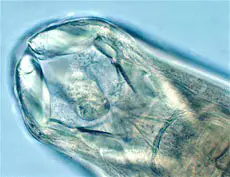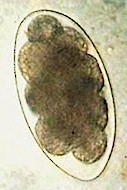Uncinaria stenocephala, also called the northern hookworm or the fox hookworm, is a parasitic roundworm that has mainly dogs and other wild carnivores (e.g. foxes, coyotes, wolves, etc.) and occasionally cats as final hosts. It can also infect humans.
is a parasitic roundworm that has mainly dogs and other wild carnivores (e.g. foxes, coyotes, wolves, etc.) and occasionally cats as final hosts. It can also infect humans.
Uncinaria stenocephala is found mainly in cooler regions of the northern Hemisphere, including Europe, Canada and the northern Unites States. In certain regions (e.g. Austria, Italy) up to 40% of the fox population can be infected with Uncinaria stenocephala.
Uncinaria stenocephala is often found in mixed infections with other common roundworms of dogs and cats such as Ancylostoma spp, Toxocara canis, Toxocara cati, etc.
The disease caused by Uncinaria stenocephala is called uncinariasis, a term that is sometimes also used for Ancylostoma spp infections.
Uncinaria stenocephala does not affect cattle, sheep, pigs, horses or poultry.
Are dogs or cats infected with Uncinaria stenocephala contagious for humans?
- YES. Quite occasionally, but not through direct contact with the pets, but mostly while walking barefoot in a places infected with Uncinaria larvae (gardens, backyards, etc.). For additional information read the chapter below on harm caused by Uncinaria stenocephala.
There are other hookworms species, mainly Ancylostoma duodenale and Necator americanus, which are specific human parasites and much more harmful than those hookworms that affect dogs and cats. Neither dogs nor cats transmit these human hookworms.
You can find additional information in this site on the general biology of parasitic worms and/or roundworms.
Final location of Uncinaria stenocephala
Predilection site of adult Uncinaria stenocephala hookworms is the small intestine, but migrating larvae can be found in the skin, in the circulatory system, the lungs, the trachea and the bronchial tubes.
Anatomy of Uncinaria stenocephala
Uncinaria stenocephala are rather small worms, 5 to 12 mm long and about 0.3 mm wide, whereby males are smaller than females. They have the typical slender shape of worms, with thinner head and tail, but the head is usually bent, which makes them look like a hook. They show a whitish to pinkish color, depending on the amount of ingested blood.
The worm's body is covered with a cuticle, which is flexible but rather tough. The worms have no external signs of segmentation. They have a tubular digestive system with two openings. The mouth capsule has two cutting plates used for cutting the gut's wall tissues for bloodsucking. These worms have also a nervous system but no excretory organs and no circulatory system, i.e. neither a heart nor blood vessels. The female ovaries are large and the uteri may contain millions of eggs. Males have simple chitinous spicules for attaching to the female during copulation.
The eggs have an ovoid shape and a thin wall, measure about 45x85 micrometers, and contain already 4 to 8 cells when shed with the feces.
Life cycle and biology of Uncinaria stenocephala
Uncinaria stenocephala has a direct life cycle, with dogs, cats and other carnivores as final hosts.

Eggs shed with the feces of a final host complete development to L3 larvae inside the droppings within 2 to 10 days after shedding, depending on temperature and humidity. They can swim in the humidity that covers the vegetation, where they wait for a suitable host. By cool and humid weather they can survive for weeks. Survival is much shorter in a dry environment or by hot weather.
The L3 larvae infect the final hosts through the mouth (after ingestion of contaminated water, food or soil) or through the skin.
Most ingested larvae reach the gut, attach and complete development to adult worms and start producing eggs. Larvae that penetrate the skin (often between the footpads) reach a blood vessel and are carried to the lungs, from where they reach the windpipe (trachea), the mouth and are subsequently swallowed.
These larvae reach the intestine, complete development to adults, attach to the gut's wall and start producing eggs. The worms bury deeply into the gut's wall and feed on the tissues, i.e. they are basically not bloodsucking.
In contrast with Ancylostoma spp hookworms, Uncinaria stenocephala is not transmitted from dams to their litter, neither during pregnancy (intrauterine transmission) nor through the milk.
The prepatent period (time between infection and shedding of first eggs in the feces) is 2 to 3 weeks, longer in case of somatic larval migration.
Harm caused by Uncinaria stenocephala , symptoms and diagnosis
Uncinaria infections are usually not heavy pathogenic for adult dogs or cats, which can develop natural resistance to it. Hemorrhage and anemia are very seldom. Intestinal disturbances with protein loss can occur, as well as inflammation of the skin (dermatitis) and the lungs caused by migrating larvae.
Reduced weight gain and potbelly can also occur in young animals. As a general rule, dogs in rural environments (hunting dogs, sheepdogs, etc.) are more likely to become infected because foxes are important hosts for these worms.
Larvae of Uncinaria stenocephala can occasionally infect humans through the skin, especially if walking barefoot on infected places (gardens, backyards, etc.). The larvae get into the skin and start migrating, causing a disease called cutaneous larva migrans. The migration paths are often visible from outside as red lines under the skin. They can be quite itchy. Sometime they break open and become infected with secondary bacteria.
These larvae usually die spontaneously with a few weeks. Nevertheless, most cases of human cutaneous larva migrans are due to Ancylostoma spphookworms, not by Uncinaria stenocephala. The specific human hookworms previously mentioned (Ancylostoma duodenale and Necator americanus) are substantially more harmful for humans than their veterinary relatives.
Diagnosis requires microscopic examination of fecal samples. ELISA (of fecal or blood samples) or PCR (Polymerase Chain Reaction) assays are also available in some countries.
Prevention and control of Uncinaria stenocephala
It is advisable to prevent pets from eating or licking soil or other substrates potentially contaminated with eggs, but this is often very difficult to achieve. In kennels, catteries and boarding houses it is essential to follow strict sanitation and disinfection of cages, boxes, and any places used by the animals. The excrements must be eliminated daily. Non-porous floors make disinfection easier and more effective.
Based on the local epidemiological situation and the pet's specific environment (rural, urban, contact with other dogs, season, climate, etc.) it can be advisable to periodically treat adult pets of both sexes with appropriate wormers as recommended by your veterinary doctor. If available and affordable, it can make sense to regularly perform a fecal examination of the dog's droppings. This is particularly important for breeding animals, whose droppings should be periodically examined: if required they have to be regularly dewormed during pregnancy.
After acquiring a new pet, young or adult, it is highly advisable to perform a fecal examination and preventatively deworm it if required. If possible, whatever clinical information should be obtained from the previous owner.
All these measures are especially important in families with young children in close contact with dogs or puppies. In addition children must be instructed to frequently clean their hands with soap before eating, and not to walk barefoot outdoors on places that could be infected with larvae of these worms (gardens, yards, etc). These measures are obviously very advisable for adults as well. On the other side it is also important to train the pets not to defecate in places where the children use to play.
There are numerous anthelmintic products (also called wormers or dewormers) effective against Uncinaria stenocephala and other roundworms. They contain active ingredients of various chemical classes such as benzimidazoles (e.g. fenbendazole, febantel, flubendazole, mebendazole), tetrahydropyrimidines (e.g. pyrantel), macrocyclic lactones (e.g. milbemycin oxime, moxidectin, selamectin), emodepside, levamisole, etc. They are often used in mixtures, sometimes with specific taenicides (mostly praziquantel) to control tapeworms as well.
Most of these pet wormers are available in formulations for oral delivery either as solids (tablets, pills, etc.) or as liquids (drenches, suspensions, etc.). In some countries there are also a few spot-ons (= squeeze-ons = pipettes) and a few injectables that are effective against Uncinaria hookworms.
Most wormers kill the worms shortly after treatment and are metabolized and/or excreted within a few hours or days. This means that they have a short residual effect, or no residual effect at all. As a consequence treated animals are cured from worms but do not remain protected against new infections. To ensure that they remain worm-free the pets have to be dewormed periodically, depending on age and the local epidemiological, ecological and climatic conditions.
Excepting a few spot-ons, other antiparasitics for external use (shampoos, soaps, sprays, powders, insecticide-impregnated collars, etc.) are not effective against any hookworms or other roundworms.
There are so far no true vaccines against Uncinaria stenocephala hookworms. To learn more about vaccines against parasites of livestock and pets click here.
Biological control of Uncinaria stenocephala hookworms (i.e. using its natural enemies) is so far not feasible.
You may be interested in an article in this site on medicinal plants against external and internal parasites.
Resistance of Uncinaria stenocephala hookworms to anthelmintics
So far there are no reports on resistance of Uncinaria stenocephala to anthelmintics.
This means that if an anthelmintic fails to achieve the expected efficacy, chance is very high that it was not due to resistance but to incorrect use, or the product was unsuited for the control of these parasites. Incorrect use is the most frequent cause of failure of antiparasitic drugs.
|
Ask your veterinary doctor! If available, follow more specific national or regional recommendations for Uncinaria stenocephala control. |